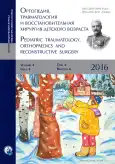Взаимосвязь сгибательных контрактур в суставах нижних конечностей и сагиттального профиля позвоночника у больных детским церебральным параличом: предварительное сообщение
- Авторы: Умнов В.В.1, Звозиль А.В.1, Умнов Д.В.1, Новиков В.А.1
-
Учреждения:
- ФГБУ «НИДОИ им. Г.И. Турнера» Минздрава России
- Выпуск: Том 4, № 4 (2016)
- Страницы: 71-76
- Раздел: Статьи
- URL: https://journal-vniispk.ru/turner/article/view/5898
- DOI: https://doi.org/10.17816/PTORS4471-76
- ID: 5898
Цитировать
Аннотация
Актуальность определяется значительной частотой развития кифоза у больных детским церебральным параличом, который вызывает боли в спине и усугубляет двигательные расстройства пациентов. Однако вопросам патогенеза данного состояния посвящено незначительное количество работ.
Цель исследования — выявить взаимосвязь между двигательными возможностями больных, степенью выраженности сгибательных контрактур коленных и тазобедренных суставов и изменениями сагиттального профиля позвоночника, а также влияния на последний хирургической коррекции сгибательной контрактуры коленного сустава.
Материал и методы. Обследованы 17 пациентов, больных детским церебральным параличом (ДЦП), в возрасте от 10 до 16 лет (13,1 ± 1,3), среди которых были 11 мальчиков и 6 девочек. Все больные были с формой спастической диплегии различной степени тяжести. По шкале нарушения глобальных моторных функций GMFCS они соответствовали 2–4-му уровням.
У 17 пациентов выполнено исследование взаимосвязи рентгенологических показателей сагиттального профиля позвоночника с двигательными возможностями детей, а также степенью выраженности у них сгибательных контрактур тазобедренных, коленных суставов и степени недостаточности активного разгибания коленных суставов. Двенадцати больным выполнена операция, направленная на коррекцию сгибательной контрактуры коленного сустава — удлинение сгибателей голени с целью анализа влияния данной контрактуры на сагиттальный профиль позвоночника. Рассмотрены следующие рентгенологические показатели — угол кифоза (УК) грудного отдела, угол лордоза (УЛ) поясничного отдела и угол наклона крестца (SS). В исследование были включены пациенты, имевшие значение УК не менее 30°.
Результаты. Согласно данным рентгенологического исследования степень выраженности кифоза составила 50,7 ± 2,1°, лордоза — 30,3 ± 4,3°, SS — 30,5 ± 3,3°. Выявлена значимая связь между кифозом и сгибательной контрактурой коленного сустава, а также между лордозом и недостаточностью активного разгибания коленного сустава. В то же время после устранения сгибательной контрактуры коленного сустава степень выраженности УК не изменилась, а УЛ и SS увеличилась приблизительно на 10°.
Заключение. Степень выраженности кифоза у больных ДЦП в основном зависит от выраженности сгибательной контрактуры коленного сустава. В то же время устранение этой контрактуры не способствует коррекции кифоза, однако увеличивает степень выраженности поясничного лордоза и наклона крестца.
Ключевые слова
Полный текст
Открыть статью на сайте журналаОб авторах
Валерий Владимирович Умнов
ФГБУ «НИДОИ им. Г.И. Турнера» Минздрава России
Автор, ответственный за переписку.
Email: umnovvv@gmail.com
д-р мед. наук, руководитель отделения детского церебрального паралича Россия
Алексей Васильевич Звозиль
ФГБУ «НИДОИ им. Г.И. Турнера» Минздрава России
Email: zvosil@mail.ru
канд. мед. наук, старший научный сотрудник отделения детского церебрального паралича Россия
Дмитрий Валерьевич Умнов
ФГБУ «НИДОИ им. Г.И. Турнера» Минздрава России
Email: fake@eco-vector.ru
канд. мед. наук, научный сотрудник отделения детского церебрального паралича Россия
Владимир Александрович Новиков
ФГБУ «НИДОИ им. Г.И. Турнера» Минздрава России
Email: fake@eco-vector.ru
научный сотрудник отделения детского церебрального паралича Россия
Список литературы
- Metaxiotis D, Wolf S, Doederlein L. Conversion of biarticular to monoarticular muscles as a component of multilevel surgery in spastic diplegia. Journal of Bone Joint Surgery. 2004;86(1):102-109.
- McCarthy JJ, Betz RR. The relationship between tight hamstrings and lumbar hypolordosis in children with cerebral palsy. Spine (Phila Pa 1976). 2000;25(2):211-3. doi: 10.1097/00007632-200001150-00011.
- Suh SW, Suh DH. Analysis of sagittal spinopelvic parameters in cerebral palsy. Clinical study. Spine. 2013;13:882-888. doi: 10.1016/j.spinee.2013.02.011.
- Van der Krogt MM, Bregman DJJ, Wisse M, et al. How Crouch Gait Can Dynamically Induce Stiff-Knee Gait. Annals of Biomedical Engineering. Springer Nature. 2010;38(4):1593-606. doi: 10.1007/s10439-010-9952-2.
- Kay RM, Rethlefsen AS, Skaggs D, et al. Outcome of medial versus combined medial and lateral hamstring lengthening surgery in cerebral palsy. Journal of Pediatric Orthopaedics. 2002;22:169-172. doi: 10.1097/01241398-200203000-00006.
- Beals RK. Treatment of knee contracture in cerebral palsy by hamstring lengthening, posterior capsulotomy, and quadriceps mechanism shortening. Dev Med Child Neurology. 2007;43(12):802-5. doi: 10.1111/j.1469-8749.2001.tb00166.x.
- Cruz AI, Ounpuu S, Deluca PA. Distal rectus femoris intramuscular lengthening for the correction of stiff-knee gait in children with cerebral palsy. Journal of Pediatric Orthopaedics. 2011;31(5):541-547. doi: 10.1097/bpo.0b013e31821f818d.
- Mac-Thiong J-M, Labell H, Berthonnaud E, et al. Sagittal spinopelvic balance in normal children and adolescents. Eur Spine J. 2007;16(2):227-234. doi: 10.1007/s00586-005-0013-8.
Дополнительные файлы







